While discoveries are being made in the Lab downstairs, I'm making my own in the Crary Library upstairs. Readers may remember my first installment of inspiring visuals from the collection a couple weeks back. Well, I'm back with some new discoveries, this time off the Rare Books shelf on a tip from my friend, artist, and Crary IT manager Karen Joyce. 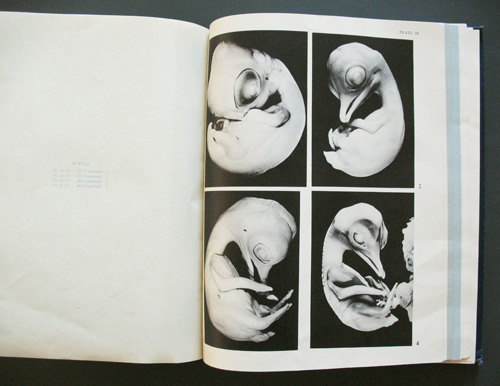 These Emperor penguin embryos appear in the Falkland Islands Dependencies Survey / Scientific Reports No. 10, published in London for the Colonial Office by her Majesty's Stationery Office in 1954. The striking black & white plates and captioned tissue interleaves make it as much an art book as a science publication.
These Emperor penguin embryos appear in the Falkland Islands Dependencies Survey / Scientific Reports No. 10, published in London for the Colonial Office by her Majesty's Stationery Office in 1954. The striking black & white plates and captioned tissue interleaves make it as much an art book as a science publication. 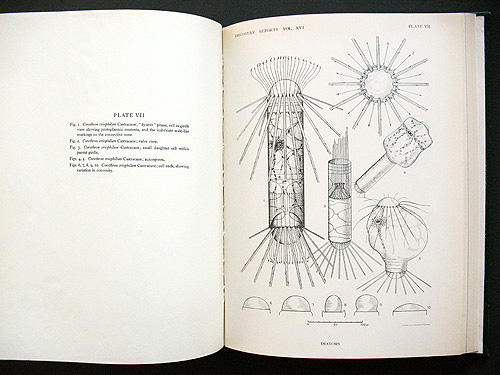 Crary has volumes upon volumes of the richly illustrated Discovery Reports published by Cambridge University Press. Subjects range from "Seasonal Formation of Laminae in the Ear Plug of the Fin Whale" to "The Plankton Diatoms of the Southern Seas," shown above. This issue is from Vol. XVI, 1937.
Crary has volumes upon volumes of the richly illustrated Discovery Reports published by Cambridge University Press. Subjects range from "Seasonal Formation of Laminae in the Ear Plug of the Fin Whale" to "The Plankton Diatoms of the Southern Seas," shown above. This issue is from Vol. XVI, 1937. 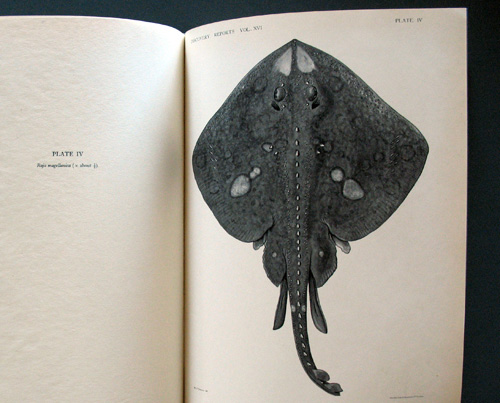 Also from Discovery Reports, a meticulously rendered Raja magellanica from the issue: "Coast Fishes: Part II. The Patagonian Region." Cambridge University Press, 1937.
Also from Discovery Reports, a meticulously rendered Raja magellanica from the issue: "Coast Fishes: Part II. The Patagonian Region." Cambridge University Press, 1937. 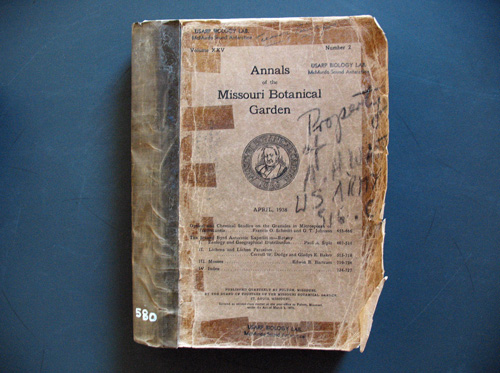 How did the Annals of the Missouri Botanical Garden find its way to a polar library? The bulk of the book, interestingly, chronicles the botanical findings of the Second Byrd Antarctic Expedition. The wear, tear and repair on this book suggests it was well-loved and much-referenced since its publication in April 1938.
How did the Annals of the Missouri Botanical Garden find its way to a polar library? The bulk of the book, interestingly, chronicles the botanical findings of the Second Byrd Antarctic Expedition. The wear, tear and repair on this book suggests it was well-loved and much-referenced since its publication in April 1938. 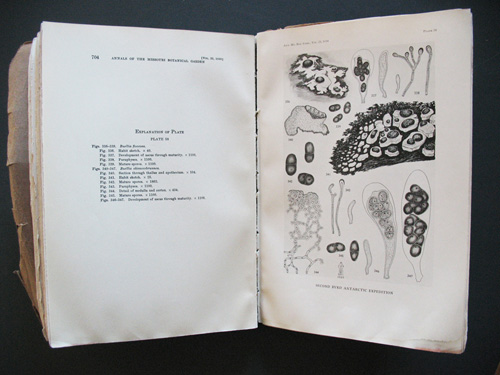 Antarctic lichens flourish in Plate 58 of the Annals of the Missouri Botanical Garden: Ascus, Paraphyses, and mature spores of the Buellia floccosa and Buellia olivaceobrunnea.
Antarctic lichens flourish in Plate 58 of the Annals of the Missouri Botanical Garden: Ascus, Paraphyses, and mature spores of the Buellia floccosa and Buellia olivaceobrunnea. 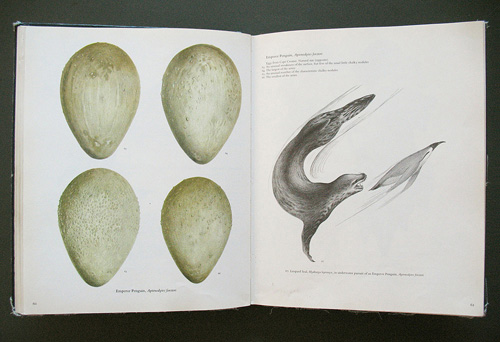 These final three spreads are from the book Edward Wilson's Birds of the Antarctic. It showcases more than 300 of Wilson's drawings and paintings created as zoologist, medical officer, and official artist on Robert Falcon Scott's two Antarctic voyages. There are 60 pages of color and 42 pages of black & white illustrations along with detailed notes and related extracts from Wilson's diaries.
These final three spreads are from the book Edward Wilson's Birds of the Antarctic. It showcases more than 300 of Wilson's drawings and paintings created as zoologist, medical officer, and official artist on Robert Falcon Scott's two Antarctic voyages. There are 60 pages of color and 42 pages of black & white illustrations along with detailed notes and related extracts from Wilson's diaries. 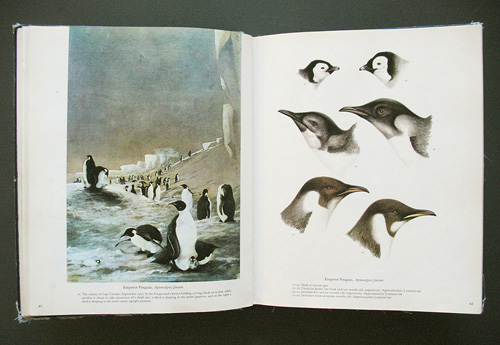 Wilson's first voyage was with the British National Antarctic (Discovery) Expedition of 1901-04 during which he completed 200 colored sketches of the Antarctic landscape and animal life, some first appearing in the home-grown South Polar Times. He also gained notoriety on this expedition for having accompanied Scott and Ernest Shackleton on a grueling trek that set a new record for southernmost travel at the time.
Wilson's first voyage was with the British National Antarctic (Discovery) Expedition of 1901-04 during which he completed 200 colored sketches of the Antarctic landscape and animal life, some first appearing in the home-grown South Polar Times. He also gained notoriety on this expedition for having accompanied Scott and Ernest Shackleton on a grueling trek that set a new record for southernmost travel at the time. 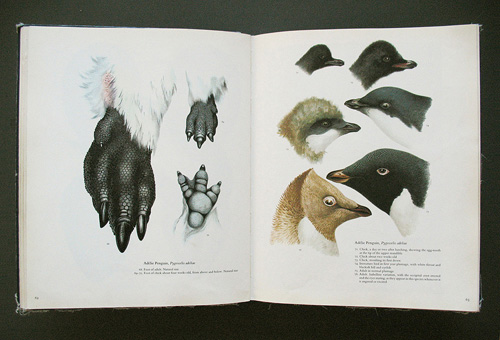 Wilson returned to Antarctica with the Terra Nova Expedition of 1910-13. The book reproduces Wilson's original record of the winter sledging journey to Cape Crozier to observe the breeding habits of the Emperor Penguin, a trip that came to be known as The Worst Journey in the World for the punishing elements the team endured. The very worst, however, came the following year when he perished with Scott and his comrades on their return from the South Pole. Today, Wilson's accurately illustrated topography and wildlife prove valuable to scientists studying ways in which the Antarctic climate and ecosystems have changed over the last century. The book's reproductions are vibrant and crisp, culled from the collection of original illustrations at the Scott Polar Institute in Cambridge, England. The Crary Library's copy is the first U.S. edition, edited by Brian Roberts and published by Humanities Press, New York, in 1968.
Wilson returned to Antarctica with the Terra Nova Expedition of 1910-13. The book reproduces Wilson's original record of the winter sledging journey to Cape Crozier to observe the breeding habits of the Emperor Penguin, a trip that came to be known as The Worst Journey in the World for the punishing elements the team endured. The very worst, however, came the following year when he perished with Scott and his comrades on their return from the South Pole. Today, Wilson's accurately illustrated topography and wildlife prove valuable to scientists studying ways in which the Antarctic climate and ecosystems have changed over the last century. The book's reproductions are vibrant and crisp, culled from the collection of original illustrations at the Scott Polar Institute in Cambridge, England. The Crary Library's copy is the first U.S. edition, edited by Brian Roberts and published by Humanities Press, New York, in 1968.